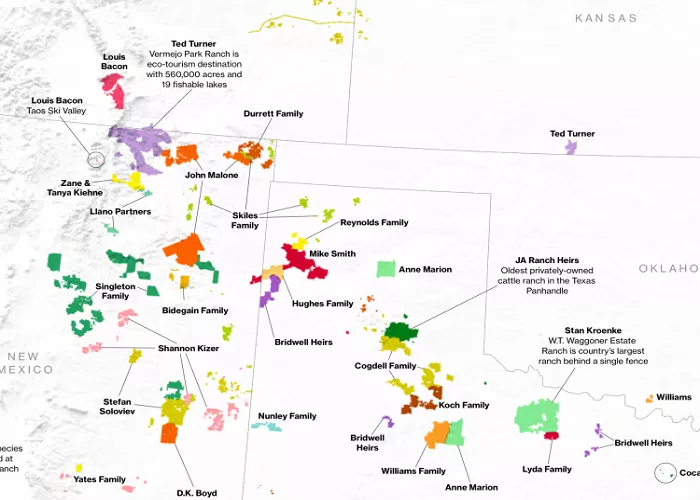Texas, known for its vast landscapes and rich history, has long been associated with expansive ranches and significant landholdings. Understanding who owns the most land in Texas provides insight into the state’s agricultural heritage, economic dynamics, and conservation efforts. This article explores the largest landowners in Texas, highlighting their contributions and the extent of their holdings.
The Largest Landowners in Texas
1. Brad Kelley – 940,000 Acres
Brad Kelley, an American businessman and conservationist, is the largest private landowner in Texas, with holdings totaling approximately 940,000 acres. Kelley’s land portfolio includes the Brewster Ranch, which spans 353,494 acres and is listed for sale at $245 million, making it one of the most expensive listings in the United States. Kelley’s approach to land ownership emphasizes conservation and sustainable land use, reflecting his commitment to preserving natural habitats.
2. Texas Pacific Land Corporation – 868,000 Acres
The Texas Pacific Land Corporation, originally chartered in 1871 to build a transcontinental railroad, now stands as one of the largest landowners in Texas, with approximately 868,000 acres. After declaring bankruptcy in 1888, the company’s vast land holdings were placed in a trust, preserving its existence for over 150 years. Today, Texas Pacific Land Corporation has evolved into a significant real estate operating company, leveraging its land assets for various revenue streams, including oil and gas royalties, water services, and land sales.
3. King Ranch Heirs – 836,000 Acres
The King Ranch, established by Captain Richard King in 1853, encompasses approximately 836,000 acres, making it larger than the state of Rhode Island. Upon King’s death in 1885, the ranch spanned 1 million acres, housing 80,000 cattle, 20,000 horses and mules, and 25,000 sheep. Today, King Ranch Inc. is owned by hundreds of his descendants, who continue to manage its diverse operations, including cattle ranching, farming, and wildlife management.
4. Caddo Sustainable Timberlands – 831,000 Acres
Caddo Sustainable Timberlands owns approximately 831,000 acres in Texas, making it the largest timberland owner in the state. The company also holds significant land in western Louisiana. More than 30 mills across both states process timber harvested from its forests, with every acre certified by the Sustainable Forestry Initiative, underscoring the company’s commitment to responsible forestry practices.
5. The Briscoe Family – 738,000 Acres
The Briscoe family, with deep roots in Texas, owns approximately 738,000 acres. Centered in Uvalde, the family’s landholdings have expanded from their South Texas origins at the Catarina Ranch to include properties in the Trans-Pecos and Rolling Plains regions. Dolph “Chip” Briscoe III currently oversees the family’s diverse ranching and banking interests.
6. O’Connor Heirs – 587,000 Acres
The O’Connor family traces its Texas land ownership back to Thomas O’Connor, an Irish immigrant who arrived in Texas in 1834. By the time of his death in 1887, O’Connor had amassed over 500,000 acres. Today, his descendants manage approximately 587,000 acres, continuing the family’s ranching legacy in the Gulf Coast region.
7. Stan Kroenke – 569,000 Acres
Stan Kroenke, a businessman with diverse investments, owns approximately 569,000 acres in Texas. Notably, he acquired the historic Waggoner Ranch in 2016, which is recognized as the largest single ranch under one fence in the United States. Kroenke Ranches has adopted holistic ecological management practices, focusing on wildlife resources and habitat conservation.
8. Jeff Bezos – 462,000 Acres
Amazon founder Jeff Bezos owns approximately 462,000 acres in Texas, primarily located north of Van Horn. Known locally as the Corn Ranch, this property serves as the base for Blue Origin’s Launch Site One, reflecting Bezos’s interest in space exploration alongside his significant land investments.
9. Hughes Family – 325,000 Acres
The Hughes family’s land ownership in Texas totals approximately 325,000 acres. Family patriarch Dan Allen Hughes Sr., who began his career as a roustabout in the oil and gas industry, invested in ranchland, including the notable Apache Ranch in Culberson County. The family continues to manage these extensive holdings, contributing to Texas’s ranching industry.
10. Mike Smith – 319,000 Acres
Mike Smith, after gaining experience in the cattle feeding industry, established his own feed yards and commodity-trading firm. His landholdings in Texas amount to approximately 319,000 acres, including the notable acquisition of the Flat Top Division of the historic Swenson Ranch. Smith’s operations reflect a blend of traditional ranching and modern agricultural practices.
Conclusion
The vast landholdings in Texas are a testament to the state’s rich history and the enduring legacy of ranching, agriculture, and conservation. From private individuals like Brad Kelley to corporations such as the Texas Pacific Land Corporation, these landowners play a significant role in shaping Texas’s landscape and economy. Their stewardship reflects a blend of traditional practices and modern innovations, ensuring that the state’s expansive terrains continue to thrive for generations to come.

